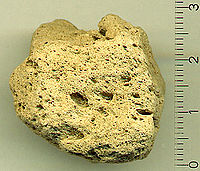
Photo from wikipedia
To make full use of urban household balcony space, an urban aquaponics system for balconies was constructed to investigate the purification effects of four different substrates (volcanic stone, ceramic pellets,… Click to show full abstract
To make full use of urban household balcony space, an urban aquaponics system for balconies was constructed to investigate the purification effects of four different substrates (volcanic stone, ceramic pellets, ceramic rings, and nanorods) and six plants (mung bean sprouts, hollow cabbage, water celery, lettuce, leek, and water chestnut) on fish culture wastewater. Through the determination of contaminants such as nitrogen and phosphorus and through the use of 16SrDNA sequencing technology, the substrate material and plant combinations with the best purification effects were screened. The results show that volcanic stone and nanorods have strong purification capacities. Compared to the other substrate types, there were more unique bacterial species on the surface of volcanic stone, among which amoeba species were the most dominant (92.42%). Among the six tested plant species, mung bean sprouts had the highest contribution to nitrogen uptake (94.96%), and water chestnut had the highest contribution to phosphorus uptake at 12.07%. Finally, the combination of nanorods and water celery was the best at purifying the wastewater. This study provides a theoretical basis and new ideas for the construction of urban aquaponics systems on balconies, which will help to achieve green farming and the efficient utilization of water resources.
Journal Title: International Journal of Environmental Research and Public Health
Year Published: 2022
Link to full text (if available)
Share on Social Media: Sign Up to like & get
recommendations!